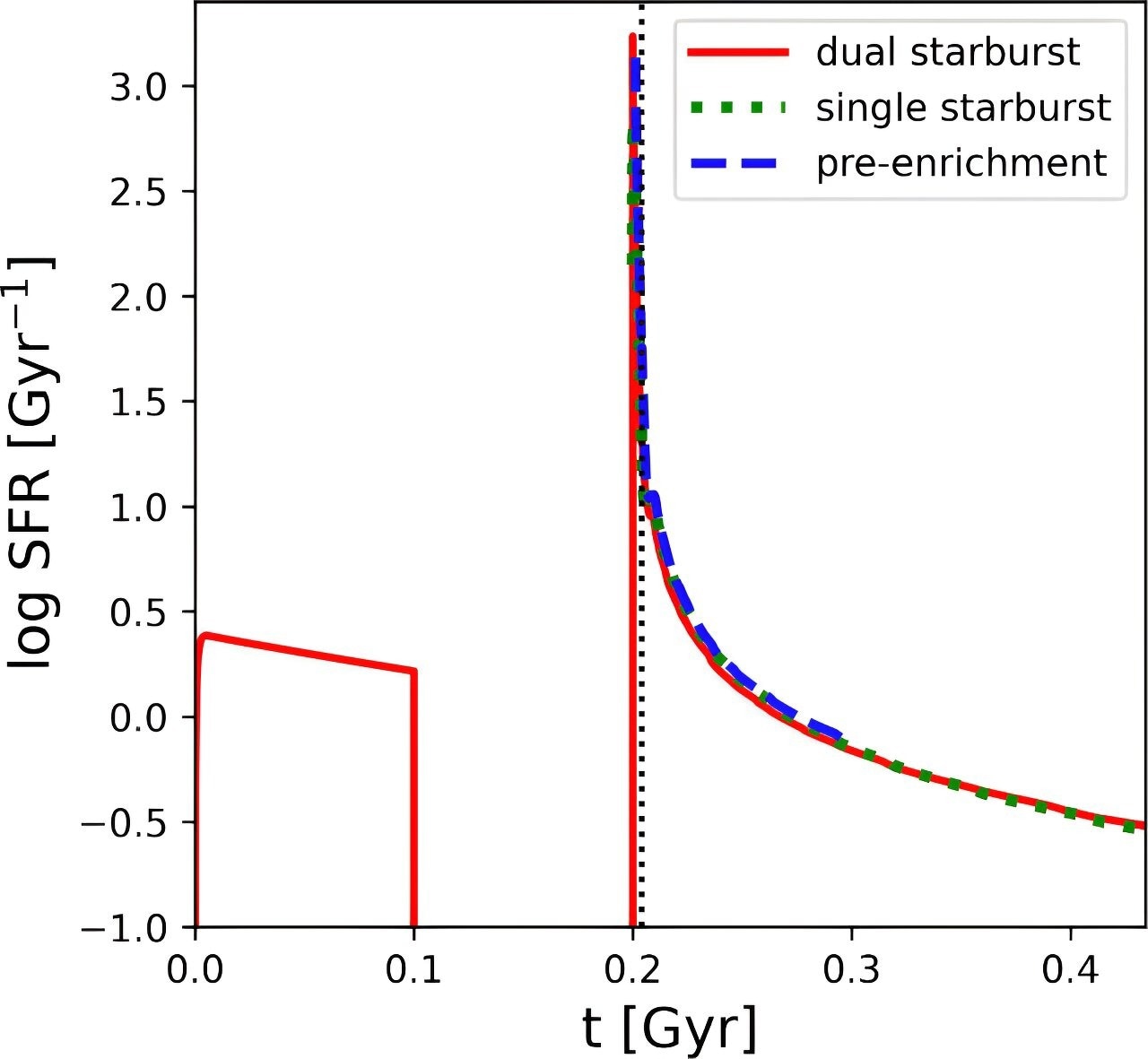Reviewed by Lexie CornerMar 8 2024
Scientists have, for the first time, elucidated the enigma surrounding the rare chemical composition found in one of the most distant galaxies of the universe.
 Star formation history adopted by three different GCE models for GN-z11: single starburst (green short dashed line); dual starburst (red solid); and single burst with pre-enrichment (blue long dashed). The vertical dotted line denotes the observed epoch of GN-z11. Image Credit: The Astrophysical Journal Letters (2024). DOI: 10.3847/2041-8213/ad1de1.
Star formation history adopted by three different GCE models for GN-z11: single starburst (green short dashed line); dual starburst (red solid); and single burst with pre-enrichment (blue long dashed). The vertical dotted line denotes the observed epoch of GN-z11. Image Credit: The Astrophysical Journal Letters (2024). DOI: 10.3847/2041-8213/ad1de1.
The groundbreaking research has introduced a cutting-edge theoretical model that could significantly enhance our comprehension of the distant universe. Professor Chiaki Kobayashi from the Centre for Astrophysics Research (CAR) at the University of Hertfordshire led this research, using the data captured by the James Webb Space Telescope (JWST).
Professor Kobayashi’s investigation focused on the galaxy GN-z11, which is believed to have ‘located’ only 440 million years after the Big Bang. Spectra captured by the JWST revealed an exceptionally high nitrogen abundance in GN-z11, a finding that has amazed several scientists.
Only light elements are generated during the Big Bang. Carbon and heavier elements are formed in stars and dispersed into the interstellar medium when the stars expire after 13.8 billion years of cosmic time.
One hypothesis proposed to explain the high nitrogen content in the galaxy was the potential production of elements from a supermassive star, estimated to be 50,000 to 100,000 times more massive than the sun.
Professor Kobayashi’s investigation has not only negated the hypothesis of supermassive stars and perhaps even the presence of a remnant supermassive black hole but has also introduced a new framework for comprehending early galaxies.
The galaxy is not telling us about an unusual star but an unusual episode of galaxy life. We found that early galaxies have 'bursty' star formation, which causes this unusual chemical composition. In the brief period in our model, estimated as only one million years, the nitrogen abundance is much more enhanced than oxygen.
Chiaki Kobayashi, Professor, Astrophysics, University of Hertfordshire
He added, “Our theoretical model—which does not require any special enrichment sources just as with common stars as in our galaxy—also predicts all elemental abundances, which we are not able to detect even with the best telescope we have now.”
The bursty star theoretical model, as explained by Professor Kobayashi, who also studies nuclear astrophysics, is key in enhancing our understanding of the early universe.
Kobayashi added, “In our model, the galaxy is experiencing an intermittent, bursty star formation, and fairly massive dying stars called Wolf-Rayet stars are producing this particular element, nitrogen, before major heavy elements such as oxygen are produced by supernovae. What we believe, and this is incredibly exciting for all those who study our universe, is that this model is witnessing a highly dramatic evolutionary phase for galaxies.”
Looking ahead to the future and considering the implications of the discovery for astrophysics, Professor Kobayashi stated, “We would like to see many more galaxies like this galaxy, with unusual chemical composition.”
We would also like to see more elements in these galaxies other than nitrogen and oxygen. Since different elements are produced from different types of stars on various timescales, elemental abundance patterns are the fossil record to understand the history of the universe. I call this approach ‘extra-galactic archaeology.
Chiaki Kobayashi, Professor, Astrophysics, University of Hertfordshire
Journal Reference:
Kobayashi, C. & Ferrara, A. (2024) Rapid Chemical Enrichment by Intermittent Star Formation in GN-z11. The Astrophysical Journal Letters. doi:10.3847/2041-8213/ad1de1.